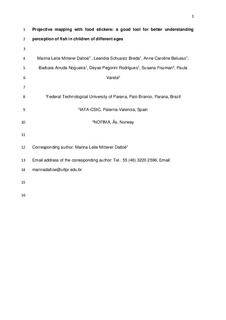Projective mapping with food stickers: A good tool for better understanding perception of fish in children of different ages
Daltoe, Marina Mitterer; Breda, Leandra Schuastz; Belusso, A.C.; Nogueira, Barbara Arruda; Rodrigues, Deyse Pegorini; Fiszman, Susana; Varela, Paula
Peer reviewed, Journal article
Accepted version
Permanent lenke
http://hdl.handle.net/11250/2494582Utgivelsesdato
2017Metadata
Vis full innførselSamlinger
- Artikler / Articles [1449]
- Publikasjoner fra CRIStin [2518]
Sammendrag
The objective of this study was to better understand the perception of fish products among school children of three different age groups, 5–6 years, 7–8 years and 9–0 years. In order to do so, we used Projective Mapping (PM) with food stickers and a word association task (WA). A total of 149 children from three public schools in the state of Parana, Brazil, have participated on this study. The age groups were interviewed (on 1–1 basis) by six monitors qualified to apply the sensory methods used. Ten stickers with drawings of healthy foods (sushi, salad, fruit, fish, chicken), and less-healthy foods (pizza, flan, cake, hamburger, french fries) were given to the children. They were then asked to stick them on an A3 sheet, in a way that the products they considered similar should be positioned close to each other, and those they considered very different should be kept apart. Afterwards, they were asked to described the images and group of images (ultra flash profile). The PM was easily used and understood by all children, and the use of images may potentially have eased its application. Result analyses showed different perceptions from the different age groups. Hedonic perceptions in relation to fish products had a higher weight in the perceptual spaces of older children. WA technique proved to be an important tool to understand fish perception by children, and reinforced the results previously obtained by PM. These results may imply that there could be a window of opportunity in which younger children will be more open to eat fish.
